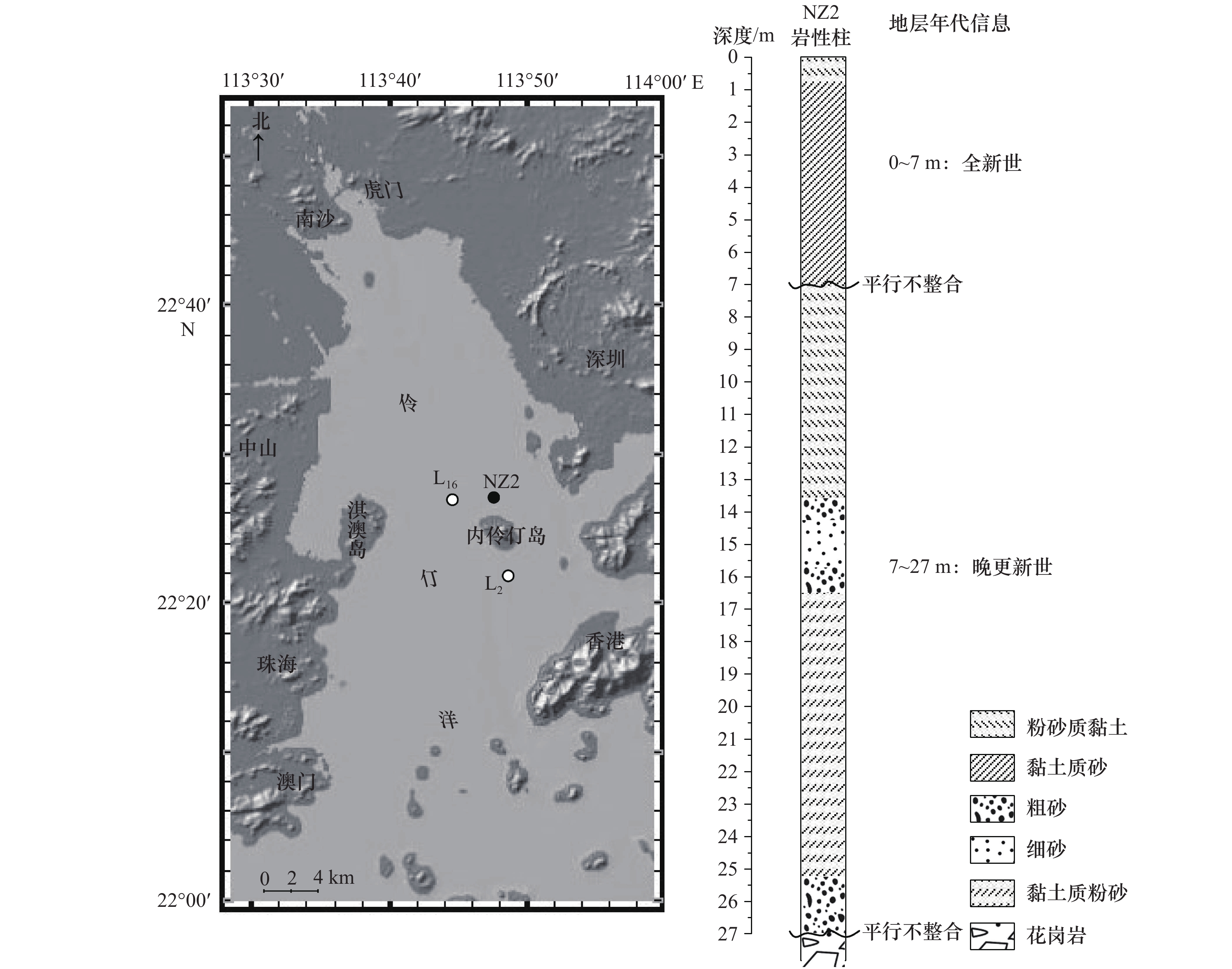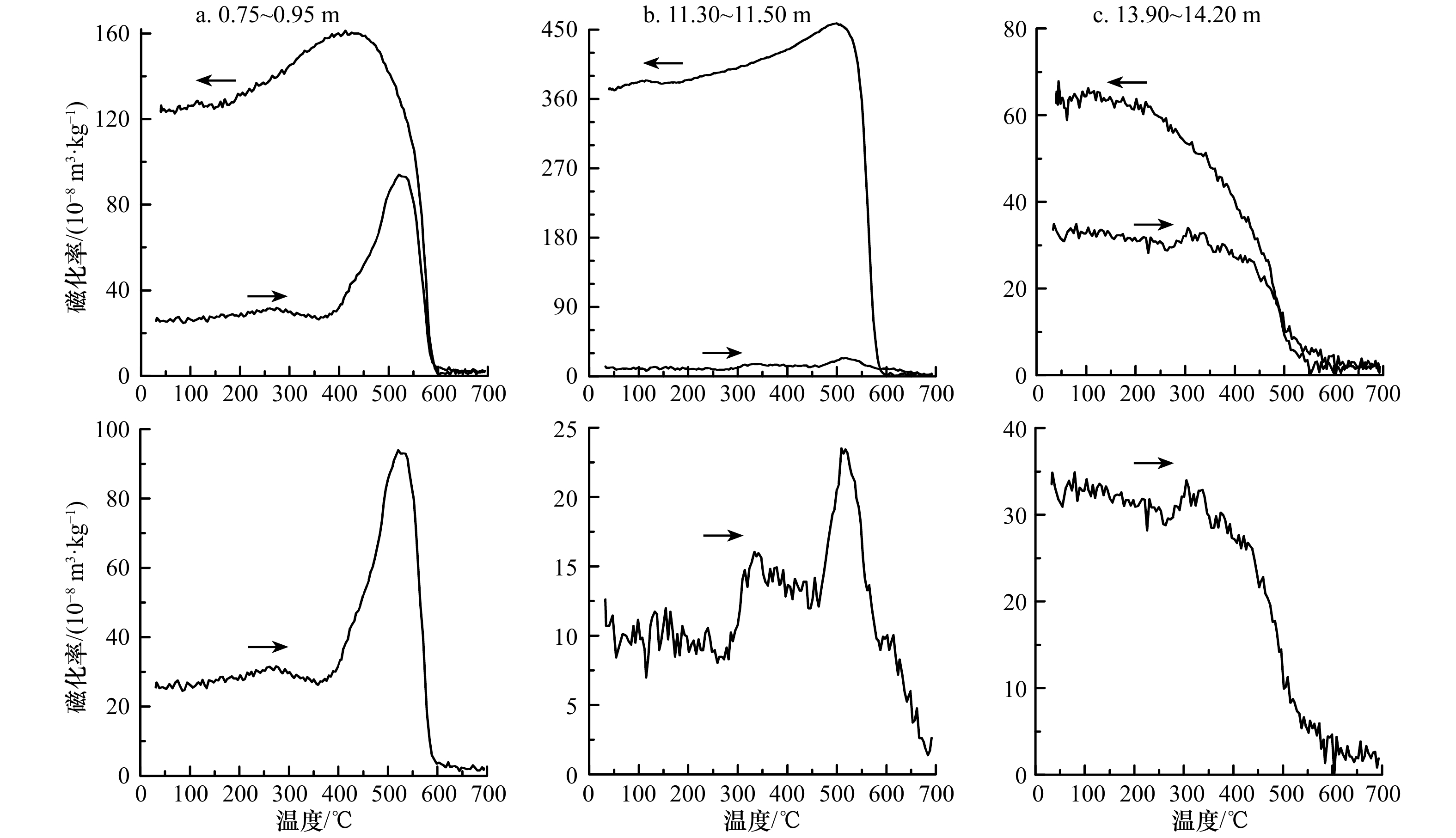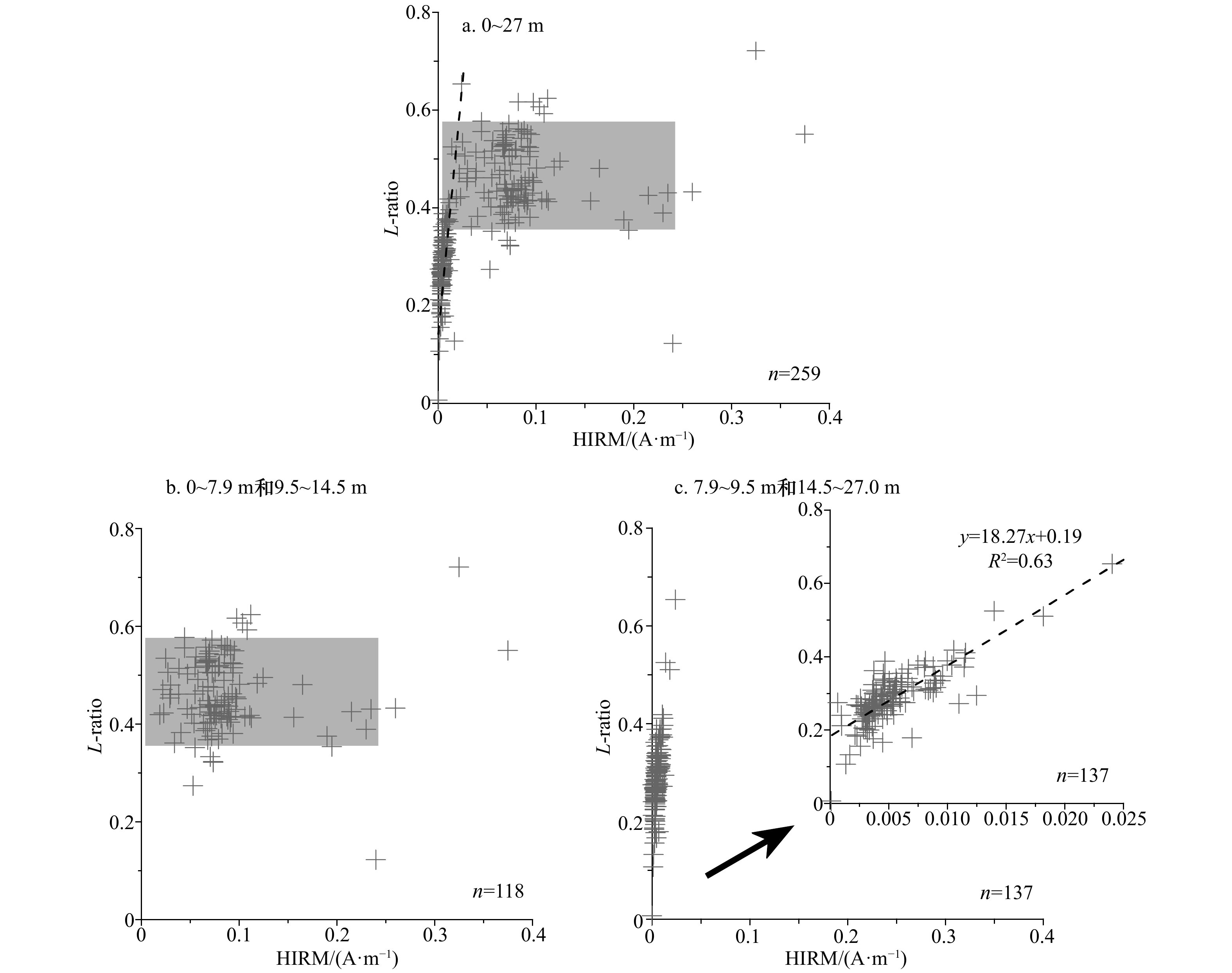Magnetic variations of sediments from a drilling core in the Lingdingyang Bay, Zhujiang River Estuary, and their responses to marine transgression and regression
-
摘要: 华南珠江三角洲河口地区受到珠江流域和近海海洋环境的共同影响,其沉积体系中承载的古地质记录对于揭示海陆交互作用下的地质地貌过程演化具有独特意义。本研究对珠江伶仃洋湾口的一条钻孔岩芯进行了环境磁学研究。研究发现,在晚更新世以来海水入侵的相对高海平面时期,岩芯沉积物中磁性矿物的组成或高矫顽力组分的来源更稳定,反映了沉积区环境的稳定性或沉积物源区的相对固定;在海水退出的风化剥蚀期,沉积序列中磁性矿物组合出现大幅度旋回变化,这表明同时期碎屑物质源区可能经历了显著的环境更替。多重磁学参数包括低频磁化率、非磁滞剩磁、饱和等温剩磁以及HIRM参数,在全岩芯中指示了比较一致的磁性变化特征;相较之下,S-ratio参数的变化更灵敏地响应了伶仃洋湾口地区海水入侵和退出背景下的沉积演化历史。Abstract: The estuary area of the Zhujiang River Delta is significantly influenced by its drainage and offshore environment. Since being under the interaction of sea and land, the depositional system within the estuary area could be of great potential to reveal the simultaneous succession of geological and geomorphic processes. This paper presents a magnetic investigation report of a sedimentary core drilled from the Lingdingyang Bay at the Zhujiang River Estuary. Results of this study show that, the concentration of magnetic minerals or the source area of the high-coercivity magnetic minerals within the core sediments is relatively constant during the two periods of relatively high sea-level (i.e., under marine transgression) since late Pleistocene, revealing a stable sedimentation environment or a relatively fixed sediment source, respectively; however, during the period of marine regression, when the weathering and denudation processes dominate, the magnetic mineral composition in sediments is characterized by significant large-scale fluctuations, possibly indicating that the source areas of detrital materials have undergone a dramatic climate evolution. Multiple environmental magnetic parameters, including low-frequency magnetic susceptibility, anhysterestic remanent magnetization, saturation isothermal remanent magnetization, and HIRM (the ‘hard’ isothermal remanent magnetization), reveal a synchronous pattern of magnetic variations through the core. In comparison, the S-ratio record of the core sediments is more sensitive to the sedimentation evolution history during the marine transgression and regression in the Lingdingyang Bay at the Zhujiang River Estuary.
-
Key words:
- Zhujiang River Estuary /
- sediment /
- magnetic variation
-
图 1 NZ2钻孔位置及地层信息
背景底图由GeoMapApp (3.6.6版)提供,NZ2站位和地层信息等根据文献[23]改绘,邻近站位L2和L16位置信息来自文献[24]
Fig. 1 Location of Core NZ2 and its stratigraphic information
Base-map was downloaded from GeoMapApp (Version 3.6.6). Stratigraphic and chronological framework information of the study Core NZ2 were modified from reference [23], and location information of two additional cores L2 and L16 from reference [24]
图 3 归一化的等温剩磁获得曲线(a)与剩磁矫顽力曲线(b)
a中虚线对应300 mT磁场时的等温剩磁获得情况(参见表1)
Fig. 3 Normalized results for saturation isothermal remanent magnetization acquisition (a) and back-field demagnetization (b) curves for representative samples
The gray dash line in a indicates the magnetic field is 300 mT (see details in Table 1)
图 4 钻孔NZ2沉积序列的磁性变化特征
灰色曲线展示了对数坐标下各参数的变化,用于与线性坐标下的结果进行对照。灰色水平线用于标记磁性变化剧烈的界限,符号“X”标记了岩芯中的6处未采样的层位
Fig. 4 Down-core magnetic variations for Core NZ2
Down-core variations for each parameter are also shown on a log scale for comparison with their counterpart curves on the linear scale. Gray horizontal lines mark the positions of dramatic shifts on the curves. The symbol "X" represents an interval with no samples collected for analysis
图 5 钻孔NZ2沉积序列的磁性矿物含量变化特征
L-ratio用于评价参数HIRM和S-ratio作为反铁磁性矿物含量指标的有效性,根据文献[28]计算得到。灰色虚线将全岩芯记录分为4个区段,符号“X”标记了岩芯中的6处未采样的层位
Fig. 5 Down-core variations of magnetic mineral contents for Core NZ2
L-ratio, calculated according to reference [28], is used to evaluate the validity of HIRM and S-ratio as content indices of antiferromagnetic minerals. Gray dashed lines divide the entire section into four phases. The symbol "X" represents an interval with no samples collected for analysis
表 1 样品等温剩磁获得特征的信息
Tab. 1 Isothermal remanent magnetization acquisition data for representative samples
取样位置/m 300 mT时的IRM/SIRM 剩磁矫顽力/mT 0~0.20 94.34% 47.2 0.75~0.95 89.52% 42.2 8.30~8.50 85.34% 45.3 11.30~11.50 84.15% 61.9 13.90~14.20 91.61% 21.8 18.70~18.90 95.50% 24.3 24.70~24.90 93.41% 39.5 表 2 伶仃洋岩芯地层划分及与珠江三角洲晚第四纪地层划分方案对比
Tab. 2 Stratigraphy divisions on core sediments from Lingdingyang Bay and their comparison with the stratigraphy framework of the Zhujiang River Delta
伶仃洋NZ2孔
(本研究)伶仃洋L2和L16孔
文献[15]珠江三角洲多钻孔资料*
文献[17−18]地层单元(深度/m) 沉积相 沉积相 年代/ka BP 地层单元(编号) 沉积相 年代/ka BP Ⅳ(0~8.3) 粉砂质黏土和黏土质砂,含贝壳、有孔虫化石及碎屑(海相层) 海相层(桂州海侵,或全新世海进沉积层) 约9.56~0 M1b 三角洲相(海相层) 8~0 (MIS 1) M1a 河流−河口通道相 10.5~8 (MIS 1) Ⅲ (8.3~16.5) 粉砂质黏土以及粗砂−细砂−粗砂分层(埋藏风化壳,陆相层) 陆相层(新会风化期,或风化与冲洪积层) 约20~9.56 T1 陆相层 120~10.5 (MIS 5a−d, 4−2) Ⅱ (16.5~25.3) 黏土质粉砂(海相层) 海相层(礼乐海侵) 约36~20 M2 浅海相层 126~120 (MIS 5e) Ⅰ(25.3~27.9) 粗砂(风化层,陆相层) 陆相层(风化壳,或珠江冲积层) 超过40~36 T2 陆相层 超过126 (MIS 6) 基底 基岩 基岩 — 基岩 — 注:*列MIS指根据氧同位素记录划分的气候阶段,奇数和偶数期分别对应间冰期和冰期气候阶段。—表示无数据。 -
[1] Nicholls R J, Cazenave A. Sea-level rise and its impact on coastal zones[J]. Science, 2010, 328(5985): 1517−1520. doi: 10.1126/science.1185782 [2] Hauer M E, Fussell E, Mueller V, et al. Sea-level rise and human migration[J]. Nature Reviews Earth & Environment, 2020, 1(1): 28−39. [3] Thompson R, Oldfield F. Environmental Magnetism[M]. London: Springer, 1986. [4] Evans M E, Heller F. Environmental Magnetism: Principles and Applications of Enviromagnetics[M]. San Diego: Academic Press, 2003. [5] Liu Qingsong, Roberts A P, Larrasoana J C, et al. Environmental magnetism: principles and applications[J]. Reviews of Geophysics, 2012, 50(4): RG4002. [6] Berner R A. Early Diagenes: A Theoretical Approach[M]. Princeton, N.J: Princeton University Press, 1980. [7] Roberts A P. Magnetic mineral diagenesis[J]. Earth-Science Reviews, 2015, 151: 1−47. doi: 10.1016/j.earscirev.2015.09.010 [8] 赵焕庭. 珠江三角洲的形成和发展[J]. 海洋学报, 1982, 4(5): 595−607.Zhao Huanting. Formation and development of the Zhujiang Delta[J]. Haiyang Xuebao, 1982, 4(5): 595−607. [9] 赵焕庭. 珠江河口演变[M]. 北京: 海洋出版社, 1990.Zhao Huanting. Evolution of the Pearl River Estuary[M]. Beijing: China Ocean Press, 1990. [10] 赵焕庭. 珠江河口特征认知的发展[J]. 海洋学报, 2018, 40(7): 1−21.Zhao Huanting. Cognitive development of characteristics of the Zhujiang River Estuary[J]. Haiyang Xuebao, 2018, 40(7): 1−21. [11] 黄镇国, 李平日, 张仲英, 等. 珠江三角洲形成发育演变[M]. 广州: 科学普及出版社广州分社, 1982.Huang Zhenguo, Li Pingri, Zhang Zhongying, et al. Formation, Development and Evolution of the Zhujiang Delta[M]. Guangzhou: Science and Technology Press of Guangzhou, 1982. [12] 黄镇国, 李平日, 张仲英, 等. 珠江三角洲第四纪沉积特征[J]. 地质论评, 1985, 31(2): 159−164. doi: 10.3321/j.issn:0371-5736.1985.02.008Huang Zhenguo, Li Pingri, Zhang Zhongying, et al. Characteristics of the Quaternary deposits in the Zhujiang (Pearl) Delta[J]. Geological Review, 1985, 31(2): 159−164. doi: 10.3321/j.issn:0371-5736.1985.02.008 [13] 徐明广, 马道修, 周青伟, 等. 珠江三角洲地区第四纪海平面变化[J]. 海洋地质与第四纪地质, 1986, 6(3): 93−102.Xu Mingguang, Ma Daoxiu, Zhou Qingwei, et al. Quaternary sea-level fluctuation in Zhujiang River Delta area[J]. Marine Geology & Quaternary Geology, 1986, 6(3): 93−102. [14] 龙云作, 霍春兰. 珠江三角洲晚第四纪沉积特征[J]. 海洋科学, 1990(4): 7−14.Long Yunzuo, Huo Chunlan. The sedimentation characteristics of Zhujiang River Delta in late Quaternary[J]. Marine Sciences, 1990(4): 7−14. [15] 陈木宏, 赵焕庭, 温孝胜, 等. 伶仃洋L2和L16孔第四纪有孔虫群与孢粉化石带特征及其地质意义[J]. 海洋地质与第四纪地质, 1994, 14(1): 11−22.Chen Muhong, Zhao Huanting, Wen Xiaosheng, et al. Quaternary foraminiferal group and sporopollen zones in cores L2 and L16 in the Lingdingyang Estuary[J]. Marine Geology & Quaternary Geology, 1994, 14(1): 11−22. [16] 杨小强, Grapes R, 周厚云, 等. 珠江三角洲沉积物的岩石磁学性质及其环境意义[J]. 中国科学D辑: 地球科学, 2008, 51(1): 56−66. doi: 10.1007/s11430-007-0151-4Yang Xiaoqiang, Grapes R, Zhou Houyun, et al. Magnetic properties of sediments from the Pearl River Delta, South China: paleoenvironmental implications[J]. Science in China Series D: Earth Sciences, 2008, 51(1): 56−66. doi: 10.1007/s11430-007-0151-4 [17] Zong Yongqiang, Yim W W S, Yu Fengling, et al. Late Quaternary environmental changes in the Pearl River mouth region, China[J]. Quaternary International, 2009, 206(1/2): 35−45. [18] 宗永强, 黄光庆, 熊海仙, 等. 珠江三角洲晚第四纪地层、海平面变化与构造运动的关系[J]. 热带地理, 2016, 36(3): 326−333.Zong Yongqiang, Huang Guangqing, Xiong Haixian, et al. Relationship between late Quaternary lithostratigraphy, sea-level change and tectonics in the Pearl River Delta[J]. Tropical Geography, 2016, 36(3): 326−333. [19] 韦惺, 吴超羽. 全新世以来珠江三角洲的地层层序和演变过程[J]. 中国科学: 地球科学, 2011, 54(10): 1523−1149. doi: 10.1007/s11430-011-4238-6Wei Xing, Wu Chaoyu. Holocene delta evolution and sequence stratigraphy of the Pearl River Delta in South China[J]. Science China Earth Sciences, 2011, 54(10): 1523−1149. doi: 10.1007/s11430-011-4238-6 [20] Xia X M, Li Y, Yang H, et al. Observations on the size and settling velocity distributions of suspended sediment in the Pearl River Estuary, China[J]. Continental Shelf Research, 2004, 24(16): 1809−1826. doi: 10.1016/j.csr.2004.06.009 [21] 李家彪. 中国区域海洋学——海洋地质学[M]. 北京: 海洋出版社, 2012.Li Jiabiao. Regional Oceanography of China Seas——Marine Geology[M]. Beijing: China Ocean Press, 2012. [22] 陈耀泰. 珠江口沉积分区[J]. 中山大学学报(自然科学版), 1995, 34(3): 109−114. doi: 10.3321/j.issn:0529-6579.1995.03.002Chen Yaotai. Sedimentation divisions of Pearl River mouth[J]. Acta Scientiarum Naturalium Universitatis Sunyatseni, 1995, 34(3): 109−114. doi: 10.3321/j.issn:0529-6579.1995.03.002 [23] 夏真, 马胜中, 梁开, 等. 珠江口伶仃洋海底沉积[J]. 海洋地质与第四纪地质, 2008, 28(2): 7−13.Xia Zhen, Ma Shengzhong, Liang Kai, et al. The characteristics analysis of sea bottom deposit in Lingdingyang Bay of the Pearl River estuary[J]. Marine Geology & Quaternary Geology, 2008, 28(2): 7−13. [24] 温孝胜, 赵焕庭, 张乔民, 等. 伶仃洋钻孔岩心的沉积特征及环境演化[J]. 海洋学报, 1997, 19(2): 121−128.Wen Xiaosheng, Zhao Huanting, Zhang Qiaomin, et al. Sedimentary characteristics and environmental evolution of a drilling hole in the Lingdingyang Estuary[J]. Haiyang Xuebao, 1997, 19(2): 121−128. [25] Xia Zhen, Jia Peihong, Ma Shengzhong, et al. Sedimentation in the Lingdingyang Bay, Pearl River Estuary, southern China[J]. Journal of Coastal Research, 2013, 66: 12−24. doi: 10.2112/SI_66_2 [26] Dunlop D J, Özdemir Ö. Rock Magnetism: Fundamentals and Frontiers[M]. New York: Cambridge University Press, 2001. [27] Deng Chenglong, Zhu Rixiang, Jackson M J, et al. Variability of the temperature-dependent susceptibility of the Holocene eolian deposits in the Chinese Loess Plateau: a pedogenesis indicator[J]. Physics and Chemistry of the Earth, Part A: Solid Earth and Geodesy, 2001, 26(11/12): 873−878. [28] Liu Qingsong, Roberts A P, Torrent J, et al. What do the HIRM and S-ratio really measure in environmental magnetism?[J]. Geochemistry, Geophysics, Geosystems, 2007, 8(9): Q09011. [29] Karlin R, Levi S. Diagenesis of magnetic minerals in recent haemipelagic sediments[J]. Nature, 1983, 303(5915): 327−330. doi: 10.1038/303327a0 [30] Karlin R. Magnetite diagenesis in marine sediments from the Oregon continental margin[J]. Journal of Geophysical Research: Solid Earth, 1990, 95(B4): 4405−4419. doi: 10.1029/JB095iB04p04405 [31] Bloemendal J, King J W, Hall F R, et al. Rock magnetism of Late Neogene and Pleistocene deep‐sea sediments: relationship to sediment source, diagenetic processes, and sediment lithology[J]. Journal of Geophysical Research: Solid Earth, 1992, 97(B4): 4361−4375. doi: 10.1029/91JB03068 [32] Yamazaki T, Abdeldayem A L, Ikehara K. Rock-magnetic changes with reduction diagenesis in Japan Sea sediments and preservation of geomagnetic secular variation in inclination during the last 30 000 years[J]. Earth, Planets and Space, 2003, 55(6): 327−340. doi: 10.1186/BF03351766 [33] Liu Jian, Zhu Rixiang, Roberts A P, et al. High-resolution analysis of early diagenetic effects on magnetic minerals in post-middle-Holocene continental shelf sediments from the Korea Strait[J]. Journal of Geophysical Research: Solid Earth, 2004, 109(B3): B03103. [34] Rowan C J, Roberts A P, Broadbent T. Reductive diagenesis, magnetite dissolution, greigite growth and paleomagnetic smoothing in marine sediments: A new view[J]. Earth and Planetary Science Letters, 2009, 277(1/2): 223−235. [35] Mohamed K J, Rey D, Rubio B, et al. Onshore–offshore gradient in reductive early diagenesis in coastal marine sediments of the Ria de Vigo, northwest Iberian Peninsula[J]. Continental Shelf Research, 2011, 31(5): 433−447. doi: 10.1016/j.csr.2010.06.006 [36] Kissel C, Laj C, Jian Z, et al. Past environmental and circulation changes in the South China Sea: Input from the magnetic properties of deep-sea sediments[J]. Quaternary Science Reviews, 2020, 236: 106263. doi: 10.1016/j.quascirev.2020.106263 [37] Zhang Weiguo, Ma Honglei, Ye Leping, et al. Magnetic and geochemical evidence of Yellow and Yangtze River influence on tidal flat deposits in northern Jiangsu Plain, China[J]. Marine Geology, 2012, 319−322: 47−56. doi: 10.1016/j.margeo.2012.07.002 [38] Liu Qingsong, Sun Youbin, Qiang Xiaoke, et al. Characterizing magnetic mineral assemblages of surface sediments from major Asian dust sources and implications for the Chinese loess magnetism[J]. Earth, Planets and Space, 2015, 67(1): 61. doi: 10.1186/s40623-015-0237-8 [39] Zan Jinbo, Fang Xiaomin, Appel E, et al. New insights into the magnetic variations of aeolian sands in the Tarim Basin and its paleoclimatic implications[J]. Physics of the Earth and Planetary Interiors, 2014, 229: 82−87. doi: 10.1016/j.pepi.2014.01.010 [40] 彭杰, 杨小强, 黄文娅, 等. 珠江三角洲全新世海平面升降及其对全球变化的响应[J]. 中山大学学报(自然科学版), 2014, 53(6): 63−72.Peng Jie, Yang Xiaoqiang, Huang Wenya, et al. Sea-level fluctuations and response to global changes during the Holocene in the Pearl River Delta, South China[J]. Acta Scientiarum Naturalium Universitatis Sunyatseni, 2014, 53(6): 63−72. [41] Kissel C, Liu Zhifei, Li Jinhua, et al. Magnetic minerals in three Asian rivers draining into the South China Sea: Pearl, Red, and Mekong Rivers[J]. Geochemistry, Geophysics, Geosystems, 2016, 17(5): 1678−1693. doi: 10.1002/2016GC006283 [42] Ouyang Tingping, Li Mingkun, Appel E, et al. Magnetic properties of surface sediments from the Pearl River Estuary and its adjacent waters: Implication for provenance[J]. Marine Geology, 2017, 390: 80−88. doi: 10.1016/j.margeo.2017.06.002 [43] Yim W W S, Li Jiaying. Diatom preservation in an inner continental shelf borehole from the South China Sea[J]. Journal of Asian Earth Sciences, 2000, 18(4): 471−488. doi: 10.1016/S1367-9120(99)00079-6 [44] Long Xiaoyong, Ji Junfeng, Balsam W. Rainfall-dependent transformations of iron oxides in a tropical saprolite transect of Hainan Island, South China: spectral and magnetic measurements[J]. Journal of Geophysical Research: Earth Surface, 2011, 116(F3): F03015. [45] Ouyang Tingping, Tang Zhihua, Zhao Xiang, et al. Magnetic mineralogy of a weathered tropical basalt, Hainan Island, South China[J]. Physics of the Earth and Planetary Interiors, 2015, 240: 105−113. doi: 10.1016/j.pepi.2015.01.001 [46] Stanley D J, Warne A G. Worldwide initiation of Holocene marine deltas by deceleration of sea-level rise[J]. Science, 1994, 265(5169): 228−231. doi: 10.1126/science.265.5169.228 [47] Woodroffe C D, Murray-Wallace C V. Sea-level rise and coastal change: the past as a guide to the future[J]. Quaternary Science Reviews, 2012, 54: 4−11. doi: 10.1016/j.quascirev.2012.05.009 [48] Zhong Lifeng, Yan Wen, Li Jie, et al. Pt and Pd in sediments from the Pearl River Estuary, South China: background levels, distribution, and source[J]. Environmental Science and Pollution Research, 2012, 19(4): 1305−1314. doi: 10.1007/s11356-011-0653-7 [49] 贾国东, 彭平安, 傅家谟. 珠江口近百年来富营养化加剧的沉积记录[J]. 第四纪研究, 2002, 22(2): 158−165. doi: 10.3321/j.issn:1001-7410.2002.02.009Jia Guodong, Peng Ping’an, Fu Jiamo. Sedimentary records of accelerated eutrophication for the last 100 years at the Pearl River estuary[J]. Quaternary Sciences, 2002, 22(2): 158−165. doi: 10.3321/j.issn:1001-7410.2002.02.009 [50] 陶慧, 王建华, 陈慧娴, 等. 伶仃洋ZK19孔全新统有机物δ13C和C/N值特征及东亚季风演变记录[J]. 中山大学学报(自然科学版), 2019, 58(3): 1−12.Tao Hui, Wang Jianhua, Chen Huixian, et al. Characteristics of δ13C and C/N in the Holocene organic material of borehole ZK19 in Lingdingyang bay and the records of east Asian Monsoon variation[J]. Acta Scientiarum Naturalium Universitatis Sunyatseni, 2019, 58(3): 1−12. -





 下载:
下载:





